What Is Sexual Assault?
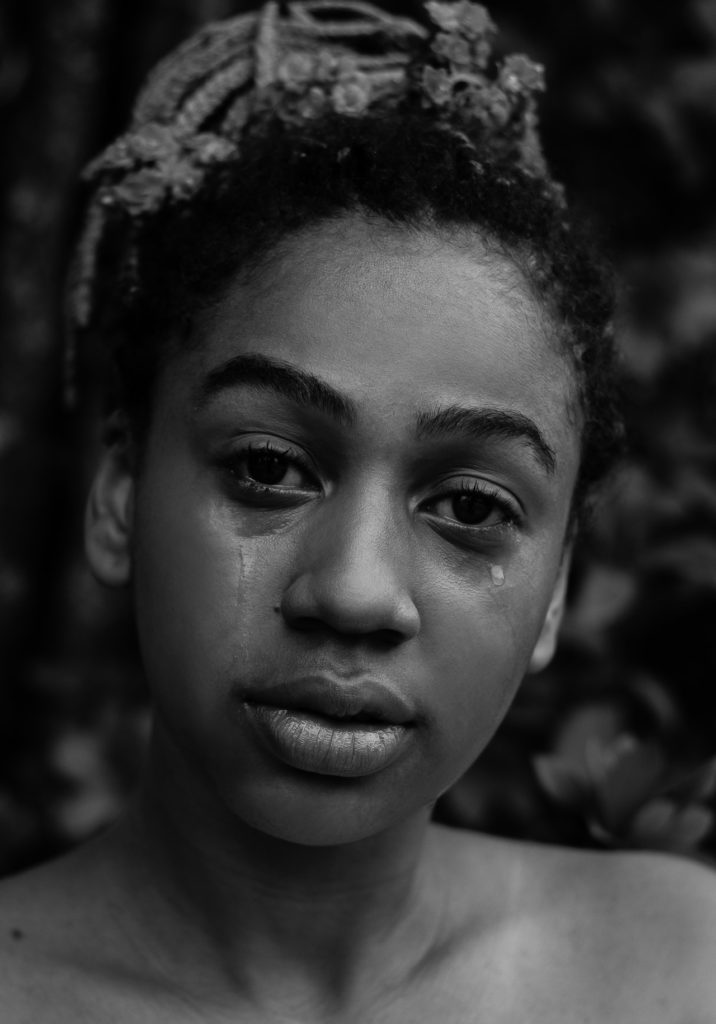
Sexual assault, or sexual abuse, refers to any malicious act and behavior that happens or forces someone without the consent of the recipient to take part in unwanted sexual
While people of all sexes and ages are victims of sexual assault, the majority of these acts are initiated by male offenders against female victims.
But, some conclusive research indicated that men [2] are also victims of sexual assault.
Younger males aged 10 and below experience sexual assault in children.
Sexual assault has a spectrum of various criminal behaviors or a number of reasons for committing such acts. The aftermath [4] and the kind of importance to the victim are often long-lasting and devastating; and most resort to silence, which makes the ordeal a recurring event.
Individuals who were sexually assaulted are, in fact, know the perpetrator in some level: they could be a family member, a romantic partner/spouse, acquaintance, or a friend.
Unfortunately, there are many highly unreported sexual assault incidences on account of fear and shame, which only encourage perpetrators to commit sexual violence on their victims over and over, giving the impression that the cases involving sexual violence are treated with little to no sensitivity.
Some Notable Examples of Sexual Assault are:
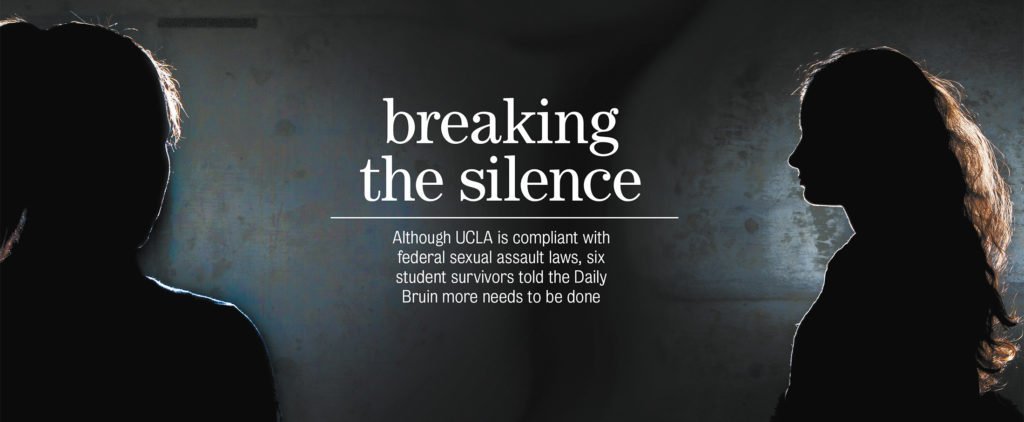
Voyeurism
Voyeurism refers to having an extreme interest and achieves sexual pleasure from watching naked people without their knowledge, or when engaged in sexual activity (such as watching pornography). Voyeurism is also a paraphilic disorder.
People with voyeuristic tendencies are diagnosed when they feel greatly distressed or become unable to function because of their behavior; or have obeyed their urges with someone who has no consent at all.
However, most voyeurs are not afflicted with this disorder, and some simply enjoy and get sexually aroused by observing individuals who disrobe, and are fully undressed.
Exhibitionism
Exhibitionism is defined as the act of exposing the genitals to achieve sexual excitement and pleasure. This behavior also includes having an extreme desire to be watched by other people. It is also a paraphilic disorder, having fantasies or impulses to commit such tendencies, and are greatly distressed when their urges are acted upon.
Most exhibitionists are not diagnosed with this disorder. The boundaries are clear to them and are often with sexual consent (part of foreplay, etc).
Incest
In some states, incest points to living together and having consensual sex between 1st-degree cousins. However, a good majority of jurisdictions allow both parties to marry.
Despite the notion that incest, even if it is consensual by two relatives leading to marriage, is considered a crime in every state.

Incest is often connected to sexual abuse since normally the victim, often a younger person (mostly children) is a recipient of unwanted sexual advantages and exploitations of an older family member.
Generally, statutes indicate that the perpetrator’s age does not fall into a specific age bracket for them to commit sexual assault by way of incest.
For the protection of the victims of incest sexual assault are fully encouraged to talk about their ordeal to a trusted adult so they are given immediate help them heal.
In the context of sexual violence in the family, the U.S.Legal defines incest as: “2) engaging in: (A) Otherwise lawful sexual intercourse or sodomy as defined by K.S.A. 21-3501 and amendments thereto; or (B) any lewd fondling, as described in subsection (a)(1) of K.S.A. 21-3503 and amendments thereto, with a person who is 16 or more years of age but under 18 years of age and who is known to the offender to be related to the offender as any of the following biological, step or adoptive relatives: Child, grandchild of any degree, brother, sister, half-brother, half-sister, uncle, aunt, nephew or niece.” [8]
Rape
Another common form of sexual assault is rape. It is defined as sexual intercourse without the recipient’s consent and with such force. It may be done through oral, vaginal, or anal penetration by a bodily part, or an object.
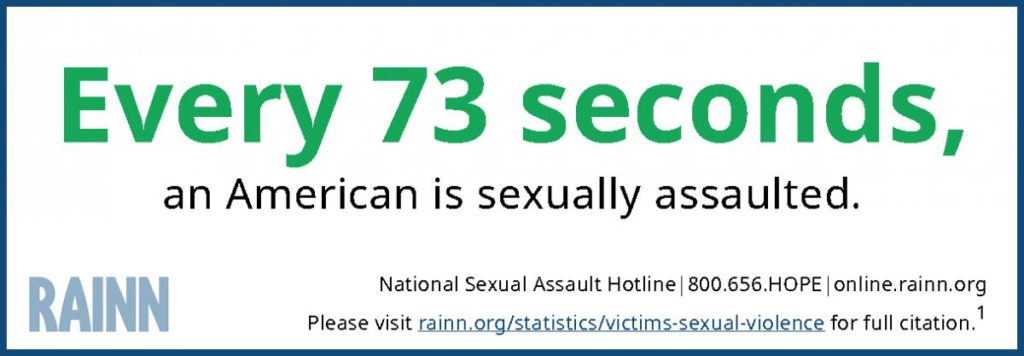
Rape happens in many circumstances: on a date using a drug slipped into a drink, while walking in a secluded area, at the workplace, and at home. [9] The aggressor could be a stranger, an acquaintance, a friend, a family member or a relative, and a co-worker or boss.
Sexual Assault Statistics in the U.S.
According to the Brennan Center for Justice, sexual assault remains dramatically underreported.
Understanding the astounding sex crime statistics that are mostly overlooked or ignored – is truly important for coming up with ways and meaningful approach to protect and support sexual assault survivors.
Sexual Assault Statistics in Females
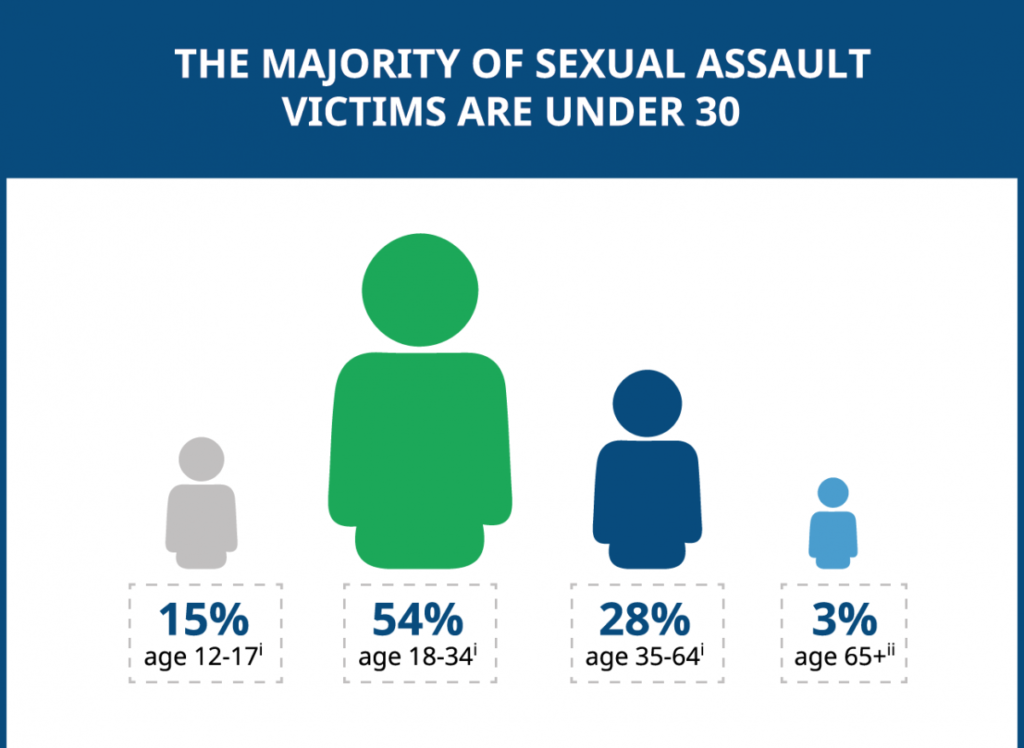
Adult women and females between the ages of 14 and 20 are three times more susceptible than adult females and younger ones in other age brackets to be assaulted or raped. [11]
Almost fifty percent of rape survivors were doing other things or asleep at home when the crime happened. Almost thirty percent were on their way to work or school, doing errands, or shopping.
In addition, some twelve percent of females were working when they were assaulted, seven percent were attending school and five percent were doing some other activity.
It was shown in the previous years that there were almost one million incidents of sexual assault that happened in jails and prisons in the United States; and that no accounts of sexual assault would be established without taking a look at the abuse going on behind bars. [12]

Contrary to the worldwide belief that men are often the perpetrators in sexual assault, it was discovered that the greatest threat to females is also their fellow female inmates, which makes them four times at risk of being sexually assaulted, rather from male penitentiary employees.
Another surprising discovery is those female inmates are at high-risk to be abused by other inmates than are male inmates – which defies the years-long perspective that sexual violence in prison is only happening among men.
The same holds true about female employees being a significant threat in juvenile corrections facilities than male staff. Research indicates that more than 8 out of ten female juveniles were sexually abused by a woman.
Sexual Assault Statistics in Males
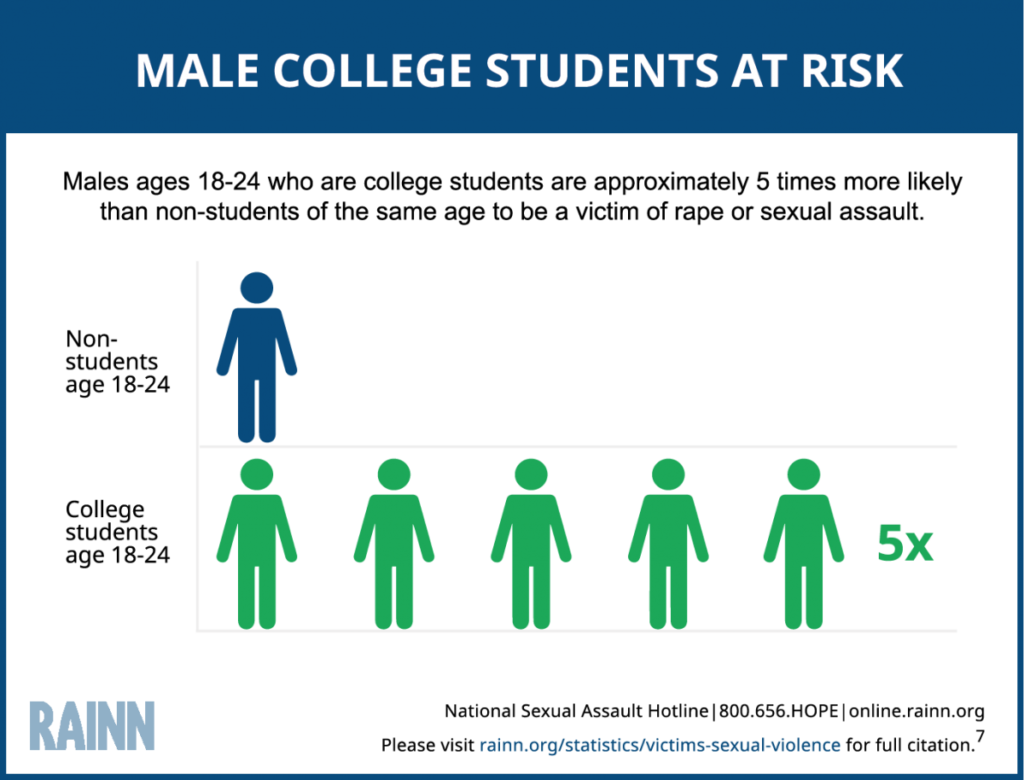
Given the society’s inescapable cultural notion that aggressors of sexual violence are by default, men – went along for many years.
This assumption, however, veils the reality as shown in a study of large-scale federal agency surveys: that women are also often perpetrators of sexual victimization.
A study was published In 2014 on the sexual victimization of men in the discovery that they were much more likely to be recipients of sexual mistreatment and exploitation than was originally thought. [14]
To better understand who was the aggressor of the abuse, four surveys were conducted and analyzed by the Centers for Disease Control and Prevention (CDC) and Bureau of Justice Statistics (BJS) to obtain a full picture of the frequency of sexual victimization done by women.
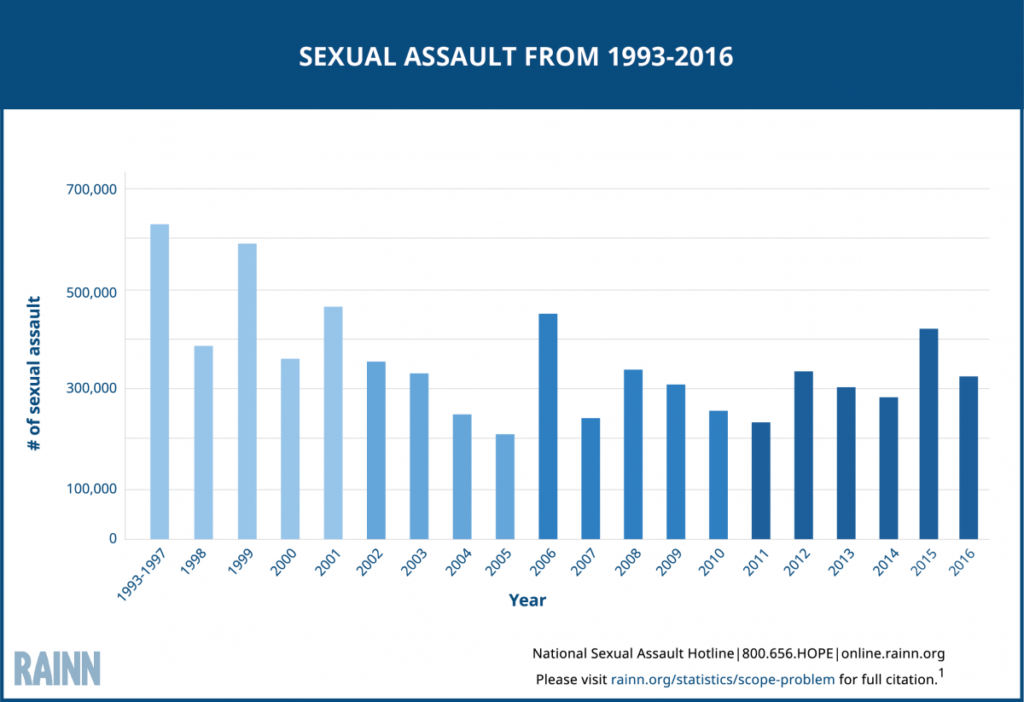
The CDC’s nationally representative study was astonishing: it showed that over one year, men and women were equally likely to experience nonconsensual sex, and most male victims reported female perpetrators. [15]
“52.4% of male victims report being raped by an acquaintance and 15.1% by a stranger.”
Likewise, a good percentage of men who have experienced unwanted sexual contact and sexual coercion were perpetrated by females.
Among those who were sexually coerced or raped by a female, nearly forty percent of female victims and fifty percent of male victims stated that they were attacked aggressively: the female aggressor attacked the victim by hitting them with an object or knocking them down, many of whom resulted to injuries.[17]
Other Gathered Data on Sexual Violence
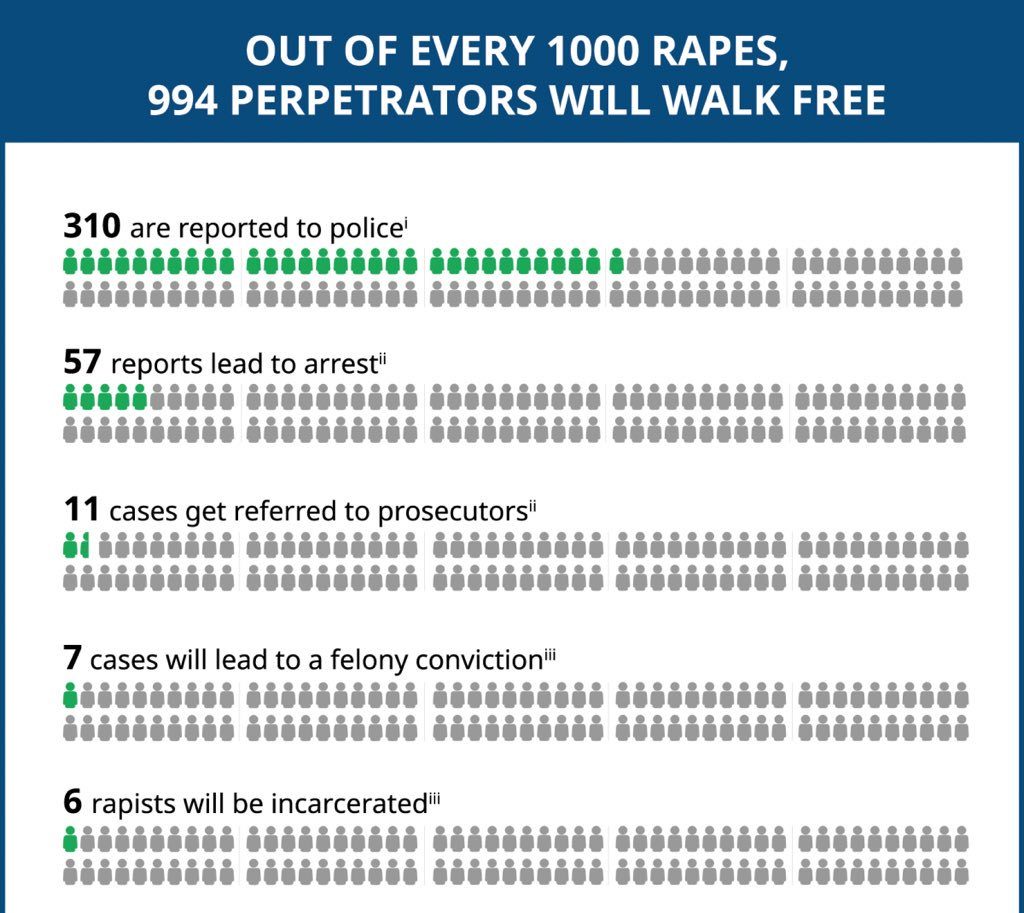
- One in six women and one in sixty men will be raped at some point in their lives. [i]
- In the U.S., one in seven men and one in three women went through some type of contact sexual violence in their lifetime.
- More than fifty percent of female victims of rape reported their aggressor was an intimate partner and more than forty percent by an acquaintance. [ii]
- American Indian women (over fifty percent) and multiracial women (almost thirty percent) experienced sexual assault at some point in their lives [iv]
- Over seventy percent of sexual assault and rape victims are female and nine percent are male.
- In eight out of ten rape cases, the victim knew the aggressor.
- Eight percent of rapes occur in the workplace.
Sexual Assault Awareness Month
April is Sexual Assault Awareness Month. In the United States, sexual assault is regarded as one of the crimes worldwide that is serious, and not to be ignored; it is even life-threatening in some cases.[18]
Sexual violence happens all over the world. Though, in several countries, there have been minimal studies and data conducted on the issue.
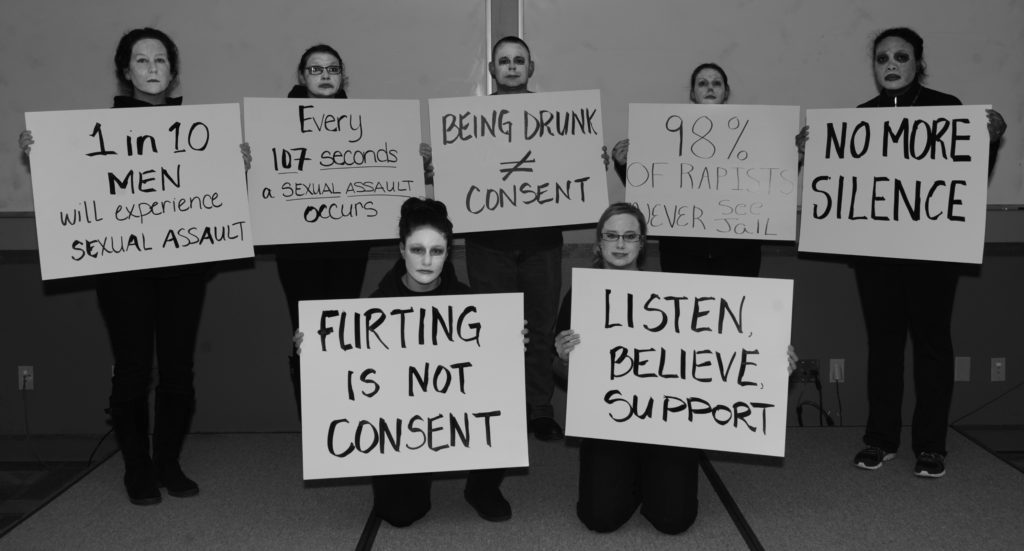
A collected data outlined that in some countries, one-third of preteen girls were coerced to have sex; being their first sexual experience, and that nearly one in five women may encounter sexual violence by an intimate partner.
Sexual assault has a deep, lasting influence mentally and physically, likewise as resulting in physical injury, it is related to an increased chance of acquiring reproductive and sexual health problems that eventually lead to immediate and long-term effects.
Its influence on mental health can be as consequential, similar to its physical effects and may be equally long-term. [19]
Statute of Limitations in Sexual Assault
There is a certain period of time for the state to charge the perpetrator when a crime is committed, and the laws that cover this time period is called criminal statutes of limitations. [20]
Though famous sexual assault cases continue to make the news, and its victims continue to fight and report crimes, it can help to better understand these laws and how they work.
What is a Criminal Statute of Limitations?
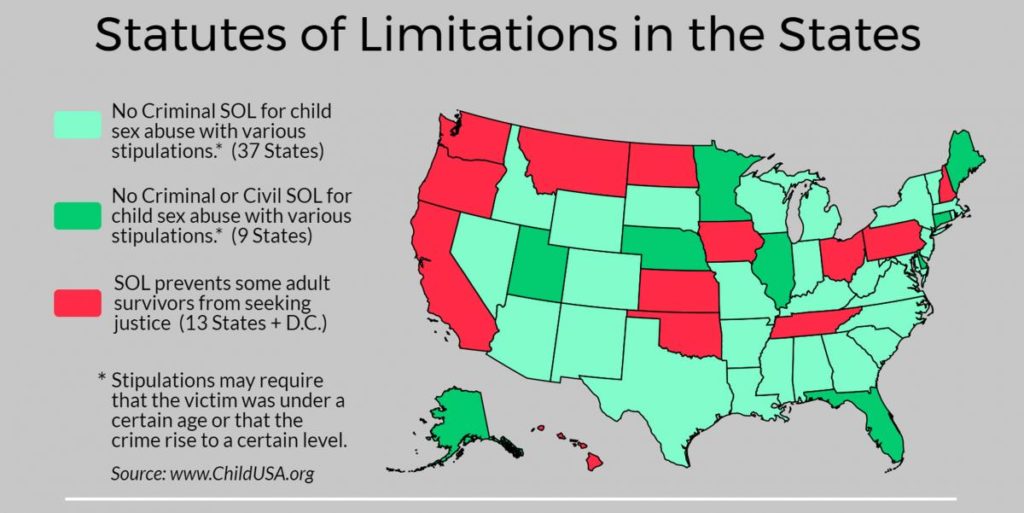
Every state has statutes of limitations that regulate the number of times the state has to charge someone with a crime.
It can be likened to a timer: it begins once the crime happens and after time runs out, the offender cannot be charged for the crime.
These statutes of limitations vary from one state to another, by incident, and type of crime. Below are the key questions that are addressed in every state’s law:
- What needs to occur to start the statute of limitations?
- What incidents cause the statute of limitations to count?
- What guarantees that certain victims, such as children, have enough time to come forward and report the crime?
How are the Statutes of Limitations Created and Applied?
The legislative assemblies are responsible for these statutes which are written and decided on. These laws differ from one state to another, despite the crime being the same.
Below are good examples:
In Alaska, the statute of limitations for rape is unlimited. Prosecutors have the liberty of pressing charges against anyone suspected of rape, despite the time frame.
A rape crime in Massachusetts follows a 15-year statute of limitations.
When a crime is prosecuted by the state, the prosecutor must first recognize which statute of limitations fits in that particular crime.
To do this, lawyers give weight to some of the following questions:
- What type of crime happened? A serious violation of a sex crime, for example, is a serious offense than a misdemeanor, the lawyers normally have a longer time to press charges against suspects.
- When did the crime happen? In many cases, the time frame for the statute of limitations begins right after the crime happens.

In some instances, such as when the victim is a minor, they may not perceive the nature of the experience until they are old enough to understand. The time frame beings in such cases when the crime was discovered, not when it happened.
- Who was involved in the crime? Lawyers will then review the victim’s identity, the alleged offender, and the relationship between them (if any) when reviewing which crime and statute of limitations fit.
Factors such as status, age, status, or if they are physically vulnerable (a child or someone with a disability) are also considered which statute of limitations applies.
- What exceptions apply? DNA evidence is crucial to a case. If so, the state may temporarily hold the statute of limitations until DNA evidence is found through the Combined DNA Index System (CODIS).
If a weapon was used in the crime, that might also influence the statutes of limitations.
Why do the Statutes of Limitations Exist?
Statutes of limitation were positioned in part to put off convictions on the basis of witness accounts; memories of past events that happened years before.
A few years ago, newer forms of evidence that were safely kept and preserved overtime is available such as text messages, emails, video/audio recordings; even DNA, and other types of digital communications. These play a very crucial role in the series of investigation and prosecution processes in crimes of sexual violence.

The society also has come to understand more about the emotional, psychological and physical effects of sexual violence and the reasons why a survivor may not step out forward immediately to issue a crime report.
These crimes and their effects have progressed over the years, so have states’ laws.
Statute of Limitations Laws in your State
RAINN’s State Law Database has an extensive list of state laws to learn further about the statute of limitations. [25]
Aside from pressing criminal charges, many victims are qualified to seek victim compensation from a state agency or to file a civil suit (a lawsuit in civil court that may seek monetary compensation, protection, or other remedies). [26]
Sexual Assault on College Campuses

Campus Sexual Assault
Sexual assault on college campuses is a common sexual violence problem that is often unreported.
It involves unwanted, forced sexual activity ranging from touching to actual rape. Drugs and alcohol always play a role in sexual violence on campuses. [27]
Fast Facts:
Sexual assault happens among female students of all ethnicities, races, and ages. One in six female college students is victimized by this crime.
Studies reveal that students pose the highest risk of sexual assault in the first few months of their semesters in college.
Females who identify as lesbian, bisexual, or gay are more susceptible to be sexually assaulted on college campuses than heterosexual women.
What percentage of women experience sexual assault while in college?
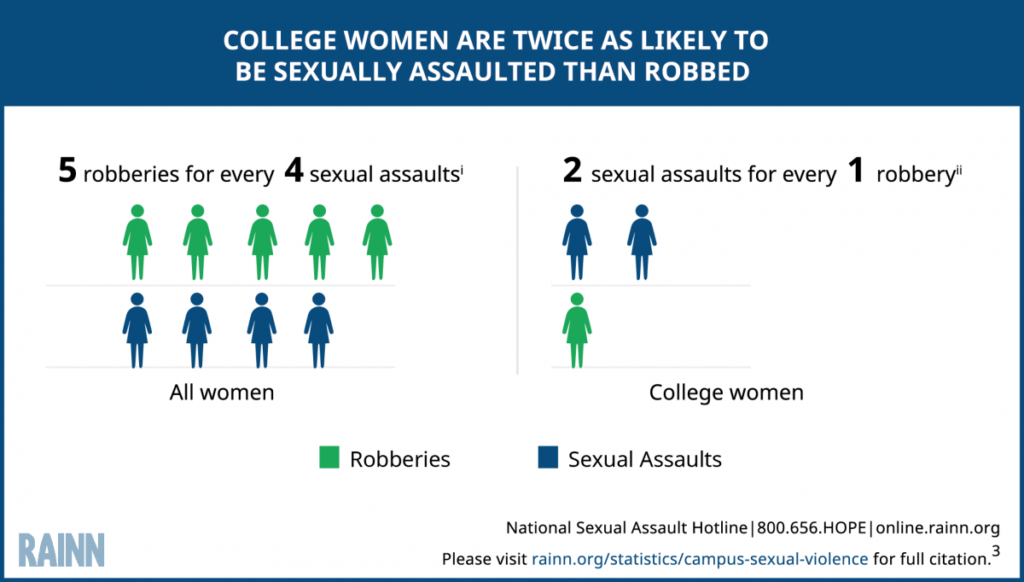
- Twenty to twenty-five percent of college females and nearly fifteen percent of college males are sexually assaulted during their time in college [28]
- A study in 2002 showed that nearly sixty-five percent of men at one university who self-reported the crime – whether it was attempted or qualifying rape confessed to committing repeated acts of this crime [29]
- Nearly ninety-percent of sexual assault college victims do not report the incident
- More than twenty-five percent of college females have experienced some form of forced sexual contact
- Almost two-thirds of college students are sexually harassed.
Sexual Assault Awareness: Degrees of Sexual Assault
Every year, millions of Americans are affected by sexual assault. The term has various actions that include unwanted contact or malicious behavior to another person without their consent.
The actions are defined by state law and can, therefore, differ by jurisdiction. However, some common examples of sexual assault are:
- Unwanted and/or forced bodily contact through groping, kissing, touching;
- Wanting to have/receive sex or oral sex with another person by way of pressuring and/or force;
- Performing bodily contact (genitals, mouth, finger, tongue) or using an object by pressuring/force, and
- Forced masturbation.
Certain laws are varied in each state. However, for the most part, sexual assault alludes to any crime in which the perpetrator forces the victim to sexual touching that is offensive and malicious.
These offenses can go from fondling, or assault/battery to attempted rape.
Each state prohibits this form of assault, but no states are the same when it comes to defining such offenses that are included within the classification of sexual assault.
The laws share some basic traits and definitions; but the scope, wording, and structures of offenses vary considerably, so always check your local statutes for specific questions.
Proving Sexual Assault Charges

The law will consider the sexual assault victim as incapacitated if the victim was physically incapable of full participation in the sexual conduct, or if they are mentally impaired to understand the nature of the sexual acts.
The use of alcohol or rape drugs is among the methods used to the victim, which makes it impossible for them to legally consent to have sex.
New laws covering this subject area have the nonconsensual sexual contact that arises between any gender and individual regardless of age. For example, several laws include involuntary sexual contact happening between two women, two men or two children, etc., not just an adult male and female.
Most states have pointed out the sexual assault as the main culprit for other crimes, such as forced physical contact and rape.
Some states determine between offenses with involuntary touching and forced sexual acts, and offenses with penetration – making the latter falls into first-degree sexual assault and the former a lower-level sexual assault.
Spousal Sexual Assault and Federal Law
Most states have also made laws to extend assaults committed by spouses.
Usually, states accomplish this in one of three ways:
- Making a separate law prohibiting sexual assault on a spouse
- Disregarding marriage as a defense to the sexual assault charge, or
- Disregarding the specific exemption for spousal assaults that appears in many laws.
The federal statute prohibiting sexual assault traces the overall principles of sexual assault mentioned above and fully restricts any sexual misconduct that happens as a result of the aggressor exerting authority and fear over the victim or threatening them. It also prohibits sexual acts to happen when the victim is mentally and physically incapacitated.
State Laws
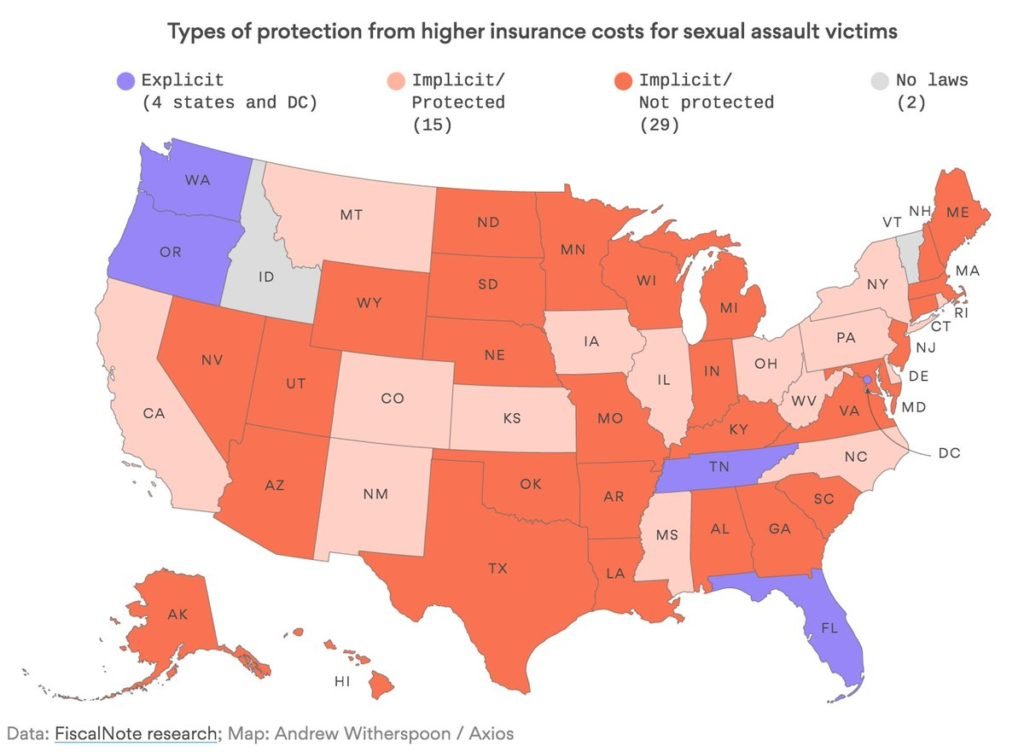
Generally, the categorization of sexual crimes is not too far from one U.S. jurisdiction to another. Often, states have a small degree of different sentencing definitions and guidelines. Also, states set apart the differing acts into varying crimes, while other states pile them all together under a single classification. [38]
Sexual Assault Hotline
Listed below are free hotline resources and websites for sexual assault victims who wish to report the crime:
- 1in6.org/helpline – A helpline for Male Survivors of Childhood Sexual Abuse and Adult Sexual Assault [24/7, free, anonymous]
- 1in6.org/supportgroup – Support Groups for Male Survivors of Childhood Sexual Abuse and Adult Sexual Assault [free, anonymous] [40]
- National Child Abuse Hotline – 1-800-422-4453 [41]
- National Coalition of Anti-Violence Programs, National Advocacy for Local LGBT Communities – 1-212-714-1141 [links to local programs] [42]
- National Sexual Assault Hotline – 1-800-656-4673 [24/7 hotline] [43]
- National Teen Dating Abuse Helpline – 1-866-331-9474 or 1-866-331-8453 (TTY) [44]
- Jennifer Ann’s Group – Free resources on teen dating violence [45]
- National Association of Crime Victim Compensation Boards [links to every state’s compensation program] [46]
Famous Sexual Assault Cases
1. Terry Crews Sexual Assault
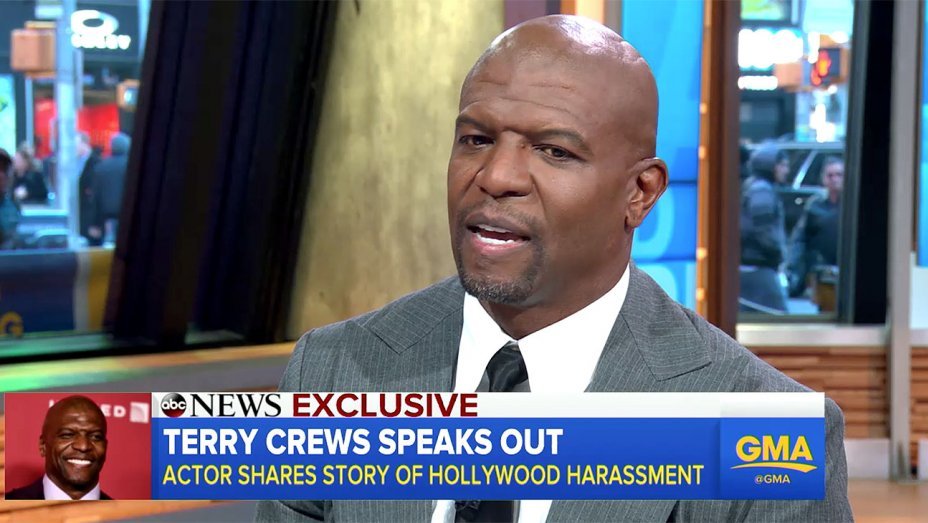
In 2017, actor Terry Crews accused Adam Venit, a Hollywood agent, of touching him at a party in 2016. [47] TerryCrews filed a police report with the Los Angeles Police Department in November.
WME, Venit’s talent agency, demoted Venit from his position as head of the Motion Picture Department in December during an investigation. But lawyers did not charge Venit because the case fell outside the statute of limitations. [49]
2. Trump Sexual Assault

As a national discussion on sexual assault is taking hold of the country from Capitol Hill to Hollywood, new attention has been directed on the sexual misconduct allegations that at least 23 women have made against Trump since the 1970s.
In October 2016, a group of women [50] made their accusations towards Trump after the controversial Hollywood tape was made public.
It was a recorded conversation [51] in which Trump was gloating about grabbing the genitals of women in 2005. Some others also had their accusations in public months prior to the tape’s release, and after.
3. Kevin Spacey Sexual Assault

Sexual assault allegations against Kevin Spacey [52] have made the US actor’s conduct, career, and life come under public scrutiny.
Actor Anthony Rapp said that Spacey made a sexual advance towards him when Rapp was a teenager. Now 46, Rapp added during a party at Spacey’s place in 1986, he laid on top of Rapp, claiming that Spacey “was trying to lure” him.
Spacey made a statement on Twitter, saying he had no recollection of the incident, but apologized to Rapp “for what would have been deeply inappropriate drunken behavior”. Spacey also added in his Twitter post that he has had intimate relationships with both women and men and that “choose[s] now to live as a gay man”. [53]
4. Cory Booker Sexual Assault

In the 1990s, U.S. Senator Cory Booker once wrote a column about groping a woman during his teenage years. It garnered news attention during the Brett Kavanaugh nomination hearing.
However, as opposed to Kavanaugh, Booker himself wrote about the incident which is how people learned about it.
According to CNN, the groping incident occurred in 1984 when Cory Booker was in his teens and wrote about it in 1992 in a column at Stanford University. [56]
- Louis Ck Sexual Assault
Several women have claimed that Louis Ck, a standup comedian, sexually harassed them. There were instances in which he masturbated in front of them. Because of the allegations, his career came to an end: the release for his new film was canceled, including his standup gig. Many media agencies have terminated their professional relationships with him as a result. [57]
Aziz Ansari Sexual Assault

Comedian-actor Aziz Ansari was accused of unwanted touching and forcing his date, named Grace, to have sex with him. [58]
During his standup show in February 2019, he went to the issue straight-on and bravely discussed the sexual assault allegation against him for the first time since the release of his brief statement in 2018.
Ansari also added that he and Grace had engaged in intimacy and was wholly consensual.



